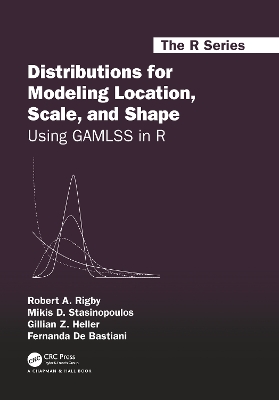Chapman & Hall/CRC The R
2 total works
Flexible Regression and Smoothing
by Mikis D. Stasinopoulos, Robert A. Rigby, Gillian Z. Heller, Vlasios Voudouris, and Fernanda De Bastiani
This book is about learning from data using the Generalized Additive Models for Location, Scale and Shape (GAMLSS). GAMLSS extends the Generalized Linear Models (GLMs) and Generalized Additive Models (GAMs) to accommodate large complex datasets, which are increasingly prevalent. GAMLSS allows any parametric distribution for the response variable and modelling all the parameters (location, scale and shape) of the distribution as linear or smooth functions of explanatory variables. This book provides a broad overview of GAMLSS methodology and how it is implemented in R. It includes a comprehensive collection of real data examples, integrated code, and figures to illustrate the methods, and is supplemented by a website with code, data and additional materials.
Distributions for Modeling Location, Scale, and Shape
by Robert A. Rigby, Mikis D. Stasinopoulos, Gillian Z. Heller, and Fernanda De Bastiani
This is a book about statistical distributions, their properties, and their application to modelling the dependence of the location, scale, and shape of the distribution of a response variable on explanatory variables. It will be especially useful to applied statisticians and data scientists in a wide range of application areas, and also to those interested in the theoretical properties of distributions. This book follows the earlier book ‘Flexible Regression and Smoothing: Using GAMLSS in R’, [Stasinopoulos et al., 2017], which focused on the GAMLSS model and software. GAMLSS (the Generalized Additive Model for Location, Scale, and Shape, [Rigby and Stasinopoulos, 2005]), is a regression framework in which the response variable can have any parametric distribution and all the distribution parameters can be modelled as linear or smooth functions of explanatory variables. The current book focuses on distributions and their application.
Key features:
- Describes over 100 distributions, (implemented in the GAMLSS packages in R), including continuous, discrete and mixed distributions.
- Comprehensive summary tables of the properties of the distributions.
- Discusses properties of distributions, including skewness, kurtosis, robustness and an important classification of tail heaviness.
- Includes mixed distributions which are continuous distributions with additional specific values with point probabilities.
- Includes many real data examples, with R code integrated in the text for ease of understanding and replication.
- Supplemented by the gamlss website.
This book will be useful for applied statisticians and data scientists in selecting a distribution for a univariate response variable and modelling its dependence on explanatory variables, and to those interested in the properties of distributions.

